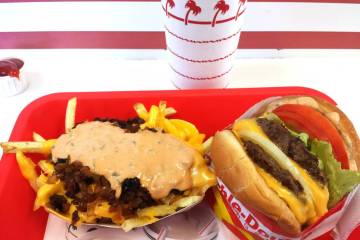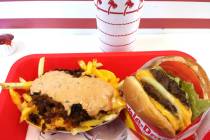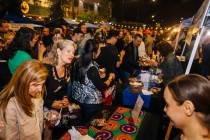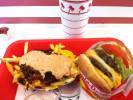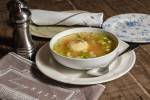Improved equipment opens up possibilities for camp cuisine
Jeff Edwards remembers well the camp cooking his family did when he was a child.
“My parents are from here, and my grandparents are from here, and they’re old pioneers,” Edwards said. “When I was a kid, anytime we went out anywhere, Dad or Grandpa would bring Dutch ovens. They’d heat up the coals, or make coals, and make Dutch-oven potatoes or chicken.”
Edwards was born in 1965, and much in his life — as in all of our lives — has changed since then, and that would include his camp-style cooking. These days, Edwards generally cooks with the propane-fueled trailer he built, which has a 4-foot griddle, 4-foot char-broiler and two-burner stove top.
He, too, used to cook with charcoal, but not anymore.
“Because I’m lazy,” Edwards said. “When I’m cooking for 100 people and I’m hauling my Dutch ovens around, that’s 20-plus Dutch ovens. I just hook up my trailer to the back of my truck and I can go.”
Yes, 100 people, sometimes more — friends, family, church members and Scouts. In September, he’ll participate in a camporee at Nelson’s Landing and cook for 200 Scouts. And so while Edwards still uses Dutch ovens, he heats them on his propane stove.
“I don’t want to get away from my roots, so I still do Dutch-oven potatoes,” he said. He starts by cooking bacon to render the fat, then sautes onions, adds the potatoes and lets everything cook.
“As soon as it is good and cooked, I throw the bacon back in and a layer of cheese on it,” Edwards said.
But his updated equipment enables him to take camp cooking to a whole new level.
“I use my stove and we’re able to do more things,” he said. “For breakfast, I like to do these cinnamon-roll pancakes. You do a regular pancake mix, and then you swirl in a mixture of brown sugar and butter and cinnamon. And then you cook that, and on top of that you put cream cheese and powdered sugar.”
He’ll make carne asada fajitas, or just put steaks on the charbroiler. For lunches he might do burgers accompanied by Dutch-oven french fries. He starts those by cutting up the potatoes, soaking them for two hours in ice water and letting them drain. Then he heats oil in the Dutch oven to 325 degrees, flash-cooks the potatoes for three minutes, then heats the oil to 400 degrees and cooks them for three more minutes.
“It browns them up real nice,” he said.
Edwards doesn’t cook professionally; his day-job hours are spent at an accounting firm. But at least a couple of local chefs say they don’t mind leaving their commercial equipment behind when they go camping — although, like Edwards, their version of “roughing it” doesn’t mean forsaking good food.
Craig Taylor, executive chef at Treasure Island, said he’s seen a lot of things change in camping.
“You can’t hardly have fires anymore,” he said, “so you have to do all your cooking on camp stoves.”
Just as in his professional kitchen, Taylor said, the key is preparation.
“I pre-cook a lot of stuff,” he said. “I’ll make, like, a Bolognese,” but not from scratch.
“I’ll pick up some sauce — Rao’s is good — and throw in some mushrooms and the beef. Camping to me is more about one-pot meals. And I’ll make garlic bread at home and wrap it in foil. All I have to do is throw it on the burner. Open a bottle of red wine and you’re good to go.”
Or he’ll make chili at home and chill it, heat it up in camp and maybe put a fried egg on top, raw onions or pico de gallo. Or meatloaf, which he’ll chill, transport to camp and then slice, wrap in foil with a couple of slabs of blue cheese and then heat until the cheese melts and the meatloaf is warm.
He’ll marinate skirt steak at home with shallots, garlic, freshly brewed coffee, Dijon mustard and brown sugar, chill and take to camp and then grill it.
“If I’m going to bring potatoes or onions, I pre-cook everything,” Taylor said. “It’s so much easier at home, where you have a real cutting board and you’re not trying to do it on your lap.”
Sometimes, though, he’ll improvise with the equipment at hand. Recently, Taylor made a sandwich, layering capicola, mortadella, salami, ham, provolone, roasted red peppers and giardiniera, sprinkled with some balsamic vinegar and some olive oil, on ciabatta. He wrapped it securely.
“I put a cooler full of beer on top of it and went fishing,” he said. “When you come back you have this amazing sandwich that’s all melded together. It was almost like a panini.”
And he’s famous — at least with his kids — for Hobo Eggs when the trip is almost over.
“That’s basically whatever I have left in the cooler — meats, cheese, jalapenos,” scrambled up with eggs, Taylor said. “If I don’t have a fire, I’ll usually just toast bread on the burner.”
Skillet cornbread, he said, is another bread option when you’re limited to a camp stove. He starts with a mix.
“Throw in some jalapenos or whatever you have,” Taylor said.
Brian Massie, the Light Group corporate executive chef, tries to tailor his camping menus to his surroundings.
“If I’m in Carmel — that area (of California) — camping on the beach, I would bring clams and all that kind of stuff,” he said. “I would bring lobster and I would bring shrimp and I would actually do a clambake.
“If I’m up in Duck Creek (in Utah), I would bring vegetables and I would make myself catch the trout from the lake.”
And if he didn’t catch trout?
“I guess I would eat vegetables,” Massie said, adding that that’s never been a problem.
“You bring all your cast-iron pans and your bacon fat you’ve been saving,” he said. “Depending on the season — you can get fresh morels right now — I would saute morals and hit the bacon fat and the trout all in one thing.”
Massie said the camp-cooking experience has changed for him now that he’s a dad, and he’s seen increased availability of equipment that makes the whole experience both easier and more pleasant.
“You walk through Bass Pro Shops, you can bring smokers, dehydrators,” he said. “The thing is you just have to prepare yourself. You have to be smart about it.”
As for Taylor, while his trailer has helped his camp cooking evolve, he sometimes goes backpacking and leaves it all behind.
“You’ve got the Mountain House dehydrated foods and the different kinds of backpacking stoves that have evolved,” he said. “When I first started I used Sterno, and now they’ve got the little propane stoves that you can put in your backpack that work real nice.”
PRESSED ITALIAN SANDWICHES
1 ciabatta loaf (about 8 by 14 by 2 inches)
½ cup store-bought black or green olive tapenade
2 tablespoons balsamic vinegar
2 tablespoons extra-virgin olive oil
¼ pound thinly sliced Genoa salami
3 ounces thinly sliced prosciutto
¼ pound thinly sliced spicy Italian cold cuts, such as capicolla
8 ounces fresh mozzarella, sliced
1 roasted red bell pepper, chopped
6 leaves fresh basil, torn into bite-size pieces
Freshly ground black pepper
Cut ciabatta in half horizontally. Spread bottom half with tapenade. Drizzle cut side of top half with vinegar and oil.
Arrange salami on top of tapenade, followed by the prosciutto, cold cuts, mozzarella, red pepper and basil. Sprinkle with pepper to taste and place top half of loaf on filling.
Wrap sandwich thoroughly with plastic wrap or foil. Place a heavy cutting board or other flat object on top of sandwich and weight it down with a 2- to 4-pound weight (such as a large pot or six-pack of soda). Let sit 30 minutes to two hours. Unwrap, cut into eighths and serve.
Serves 8.
— Recipe from Sunset
TOFU AND EGGPLANT HOBO BUNDLES
For tofu and eggplant:
20 ounces firm tofu, cut into 16 chunks
12 ounces Asian eggplant, quartered lengthwise and cut into chunks
2 tablespoons minced ginger
2 tablespoons minced garlic
¼ cup reduced-sodium soy sauce
5 tablespoons vegetable oil
2 green onions, chopped
For salad and serving:
1 English cucumber, halved and cut into chunks
1 cup cilantro leaves
1 cup whole dill sprigs
1 red jalapeno chili, halved and sliced
2 tablespoons lime juice
2 tablespoons vegetable oil
½ teaspoon kosher salt
Cooked rice and soy sauce
To make tofu and eggplant, combine ingredients in a resealable plastic bag; seal, turn and chill at least 1 hour.
Heat grill to high (450 to 550 degrees; you can hold your hand 5 inches above the cooking grate only two to four seconds). Divide tofu mixture among four large squares of foil and seal securely. Grill bundles, turning once, until eggplant is tender when pierced, about 10 minutes.
To make salad, mix all ingredients except rice and soy sauce. Unwrap bundles and top with salad. Serve with rice and soy sauce.
Serves 4.
— Recipe from Sunset
CAMPFIRE CHICKEN STEW
1 broiler/fryer chicken (3½ to 4 pounds), cut up
3 to 4 medium potatoes, peeled and sliced
1 cup thinly sliced carrots
1 medium green pepper, sliced
1 can (10¾ ounces) condensed cream of mushroom soup, undiluted
¼ cup water
½ teaspoon salt
¼ teaspoon pepper
Grill chicken, covered, over medium heat for 3 minutes on each side. Place two pieces of chicken on each of four double thicknesses of heavy-duty foil (about 18 by 12 inches). Divide the potatoes, carrots and green pepper among the packets. Top each with soup, water, salt and pepper. Fold foil around mixture and seal tightly.
Grill, covered, over medium heat for 20-25 minutes on each side or until chicken juices run clear. Open foil carefully to allow steam to escape.
Serves 4.
— Recipe from Taste of Home
FISH COOKED WITH CURRIED COUSCOUS
Olive oil spray or nonstick cooking spray
²/³ cup uncooked couscous
3 green onions, thinly sliced
½ cup slivered almonds
½ cup raisins
2 teaspoons curry powder
½ teaspoon cayenne
1 teaspoon salt, plus more for sprinkling
1½ cups chicken broth or water (divided use)
4 6-ounce cod or salmon fillets or 1½ pounds shrimp or scallops
¼ cup butter, cut into pieces
Spray four squares of aluminum foil with olive oil or cooking spray. Mix the couscous, green onions, almonds, raisins, curry powder, cayenne and salt in a small bowl or pot until well combined. Stir in ¾ cup of the chicken broth.
Place one quarter of the couscous mixture on each sheet of foil and top with one fish fillet, or one fourth of the seafood. Top with butter and sprinkle with salt, to taste.
Fold up the sides of the foil and pour a quarter of the remaining chicken broth into each packet. Double-fold the top and sides of each packet, leaving a bit of room for heat and steam to circulate inside.
Grill the packets over high heat for about 15 minutes, until the fish or seafood is cooked through and the couscous is tender. Serve immediately.
Serves 4.
— Recipe from “Campfire Cuisine” by Robin Donovan
S’MORADILLAS
4 small flour tortillas
½ cup semisweet mini chocolate chips
½ cup mini marshmallows
Cinnamon, to taste
Place two tortillas on the grill over high heat. Top each with half of the chocolate chips, half of the marshmallows and a sprinkle of cinnamon. Place the remaining two tortillas on top.
Cook for 3 to 4 minutes, until the bottom tortilla is slightly brown and crisp. Carefully flip the tortillas. Cook for 3 to 4 minutes more, until the second side is lightly browned and crisp. Cut each into quarters and serve.
Serves 4.
— Recipe from “Campfire Cuisine” by Robin Donovan
HOT QUICK BANANA BOATS
4 large unpeeled bananas
8 teaspoons semisweet chocolate chips
8 teaspoons trail mix
¼ cup miniature marshmallows
Place each banana on a 12-inch square of foil; crimp and shape foil around bananas so they sit flat.
Cut each banana lengthwise about ½ inch deep, leaving ½ inch uncut at both ends. Gently pull each banana peel open, forming a pocket. Fill pockets with chocolate chips, trail mix and marshmallows.
Grill bananas, covered, over medium heat for 4-5 minutes, or until marshmallows are melted and golden brown.
Serves 4.
— Recipe from Taste of Home




